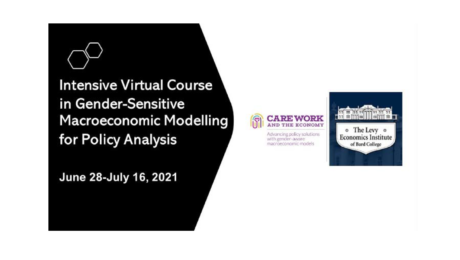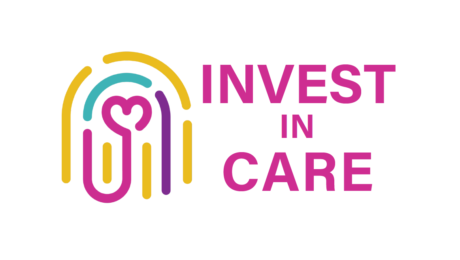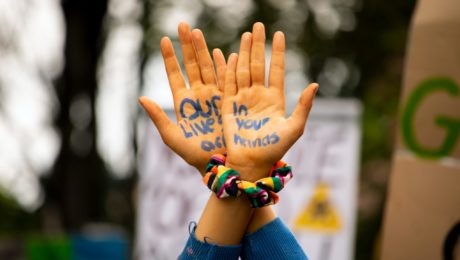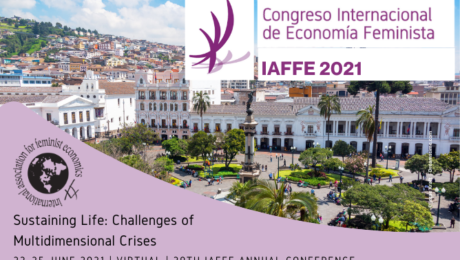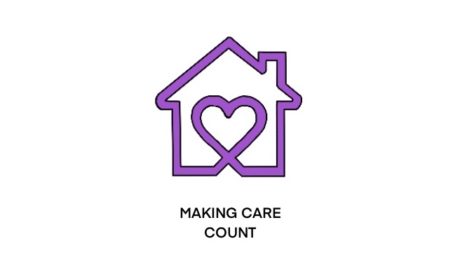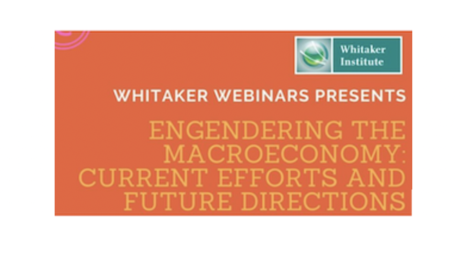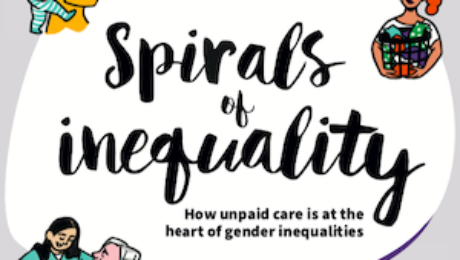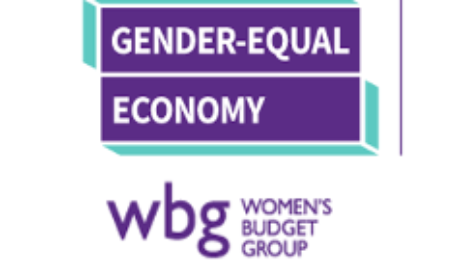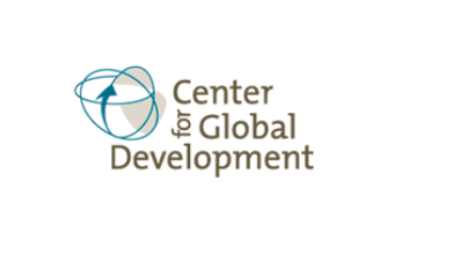Fellows Reflect on Intensive Course in Gender-Aware Macro Modeling
Last month, the Care Work and the Economy project partnered with the Levy Economics Institute at Bard College to host a three-week Intensive Course in Gender-Sensitive Macroeconomic Modelling taught in three time zones. The course aimed to engage our internationally diverse pool of Fellows to enhance capacity building in research and teaching of gender-sensitive economic analysis, focusing on care and macroeconomic policy aspects.
The course was built on four pillars:
1. Understanding and measuring the care economy
2. Adapting social accounting matrices to account for paid and unpaid care activities.
3. The use of information from time-use surveys on unpaid care activities with other relevant sources and information such as national income accounts, labor force surveys, and household or special surveys
4. Performing policy-relevant economic analyses that take systematic account of the interlinkages between care, macroeconomic processes, and distribution.
With 72 Fellows from 22 countries, including Colombia, Ghana, Mexico, Mongolia (to name a few), discussions around course material were perspective-rich and interdisciplinary. Reflecting on the course, many Fellows expressed the desire to integrate the teachings of the intensive course into their research agendas or current positions:
“I am delighted [to be a part of] a fantastic cohort and faculty who want to, and actually do, think critically about [macroeconomic] modelling in a gender-aware or feminist context…I am excited about the possibility of applying what I have learned to Cuban and Latin American contexts, [and] I would like to delve deeper into the Levy Micro-Macro model to analyze gender differences [in] the Ecuadorian context using time-use data.” — Anamary Maqueira Linares, Ph.D. student at University of Massachusetts, Amherst from Ecuador
“Inspired by Professor Folbre’s [lecture], I would like to conduct research using updated time-use surveys (such as the Mexican case)…I would like to explore the differences between time-use patterns in rural areas versus urban ones in Mexico and compare data from 2014 to the recent time-use survey in 2019. I am also organizing a workshop with the Mexican Statistics Agency [to explore] how the Mexican database was built (contrasted with other countries’ surveys) and promote its use among Mexican graduate students and policymakers.” — Dulce Guevara Lopez, consultant at the Mexican Centre for Innovation in Solar Energy
“It was interesting to learn how care and social reproduction interact with gender inequality in the labour market to determine economic growth/development. I think that [this would be] a good research perspective in the African context to see how household commodities and care-time interact with the gender segmented labour market to determine economic growth.” — Dr. Mamaye Thiongane, research associate at the Regional Consortium for Research in Generational Economy (CREG) and lecturer in economics at the Public Economics Laboratory (LEP)
“The discussions around the care diamond gave me a framework to think through the situation of community health workers in India. I plan to apply the Levy model and the care dependency ratio to the time-use survey for India. The course also helped me gather feminist insights to incorporate into the macro course that I teach at university.” — Dr. Anjana Thampi, assistant professor of economics at O. P. Jindal Global University, India
“The course was a fantastic deep-dive into the theory and practice of [macroeconomic] modelling for care, and sparked new ideas for my Ph.D. research. At a time when distances feel huge, the conversations and connections with lecturers and colleagues created a sense of closeness; something I will treasure this summer.” — Maria Sandoval Guzman, Ph.D. candidate in Economics at Curtin University in Australia, and scholar at the Bankwest Curtin Economics Centre and the Women in Social Economic Research Cluster
This course has strengthened the network of researchers around the world dedicated to gender equality and proper care valuation; thank you to all Fellows, Instructors, and Facilitators for their contributions. To learn more about the course, instructors, and Fellows, click here.
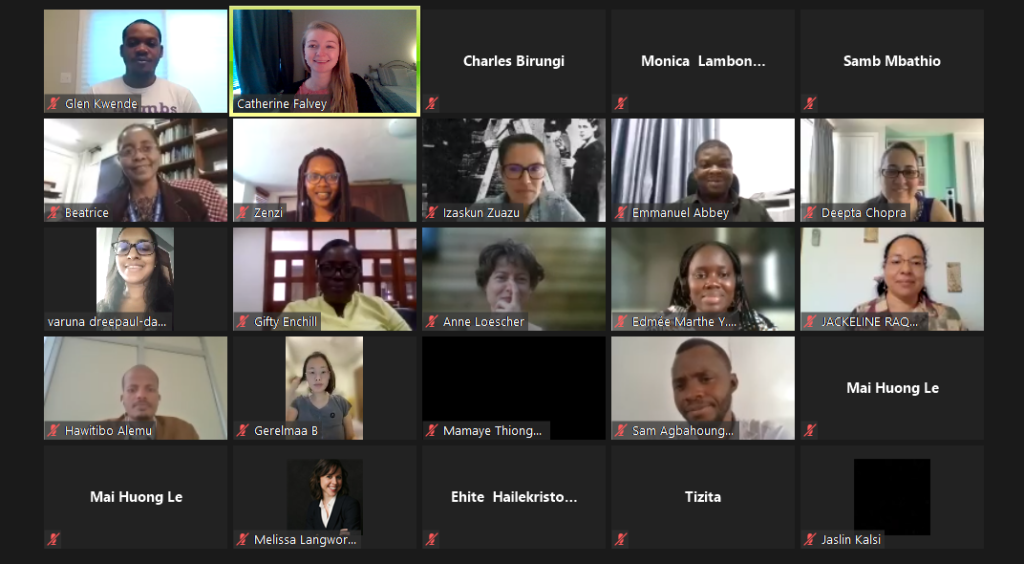
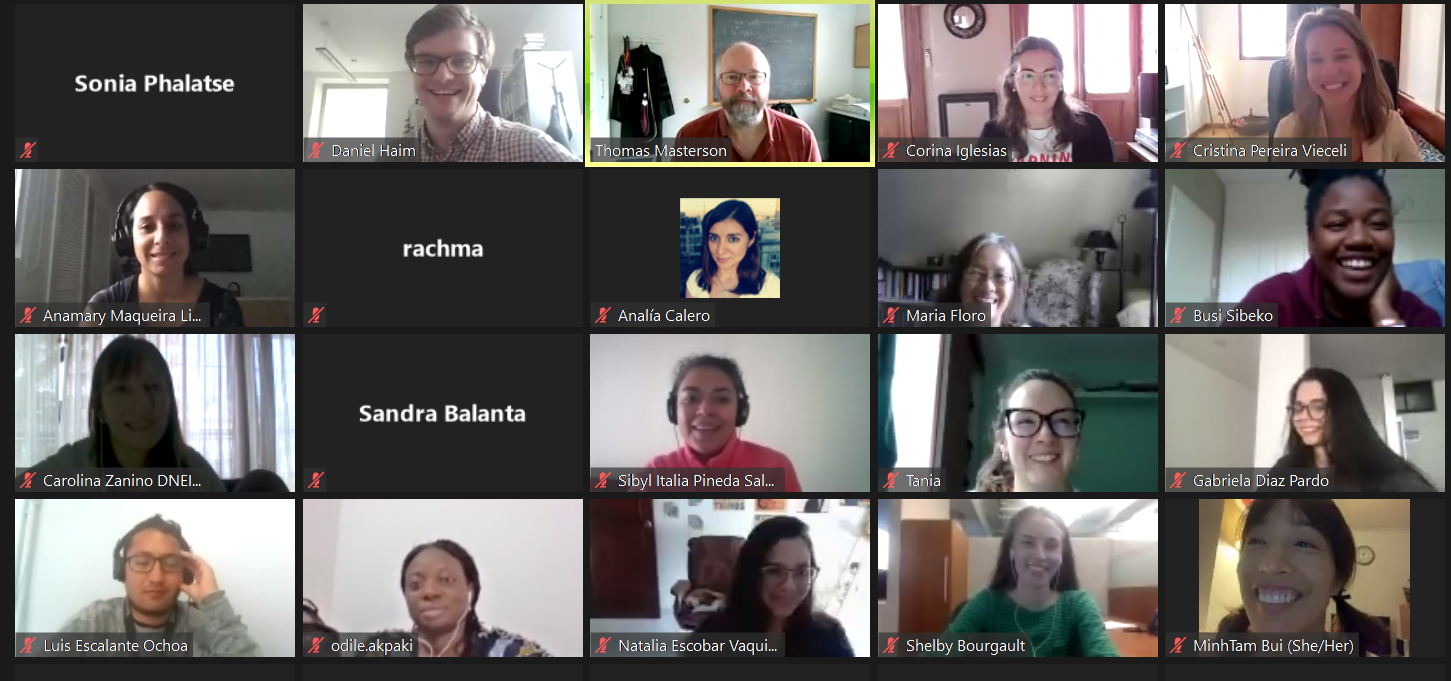
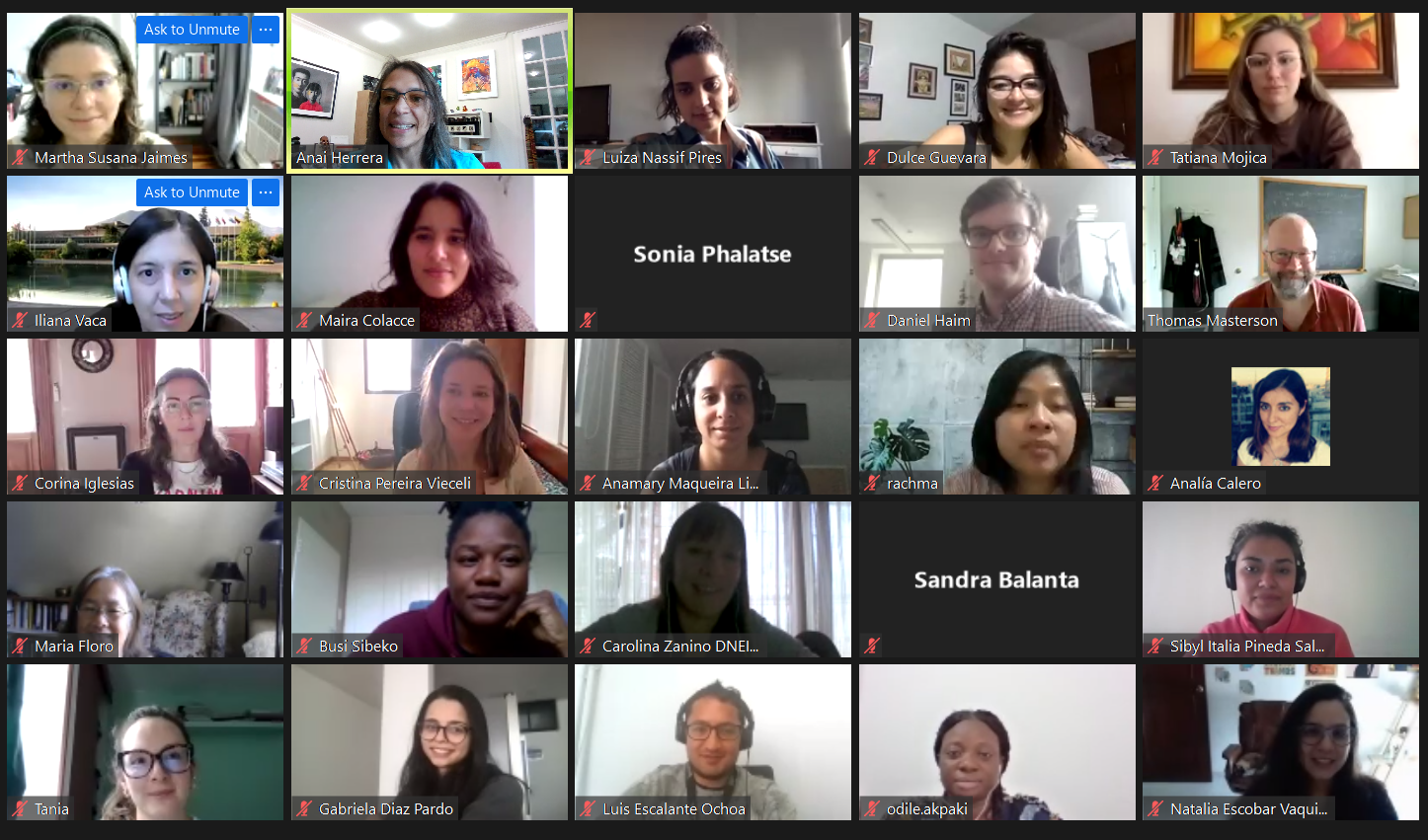
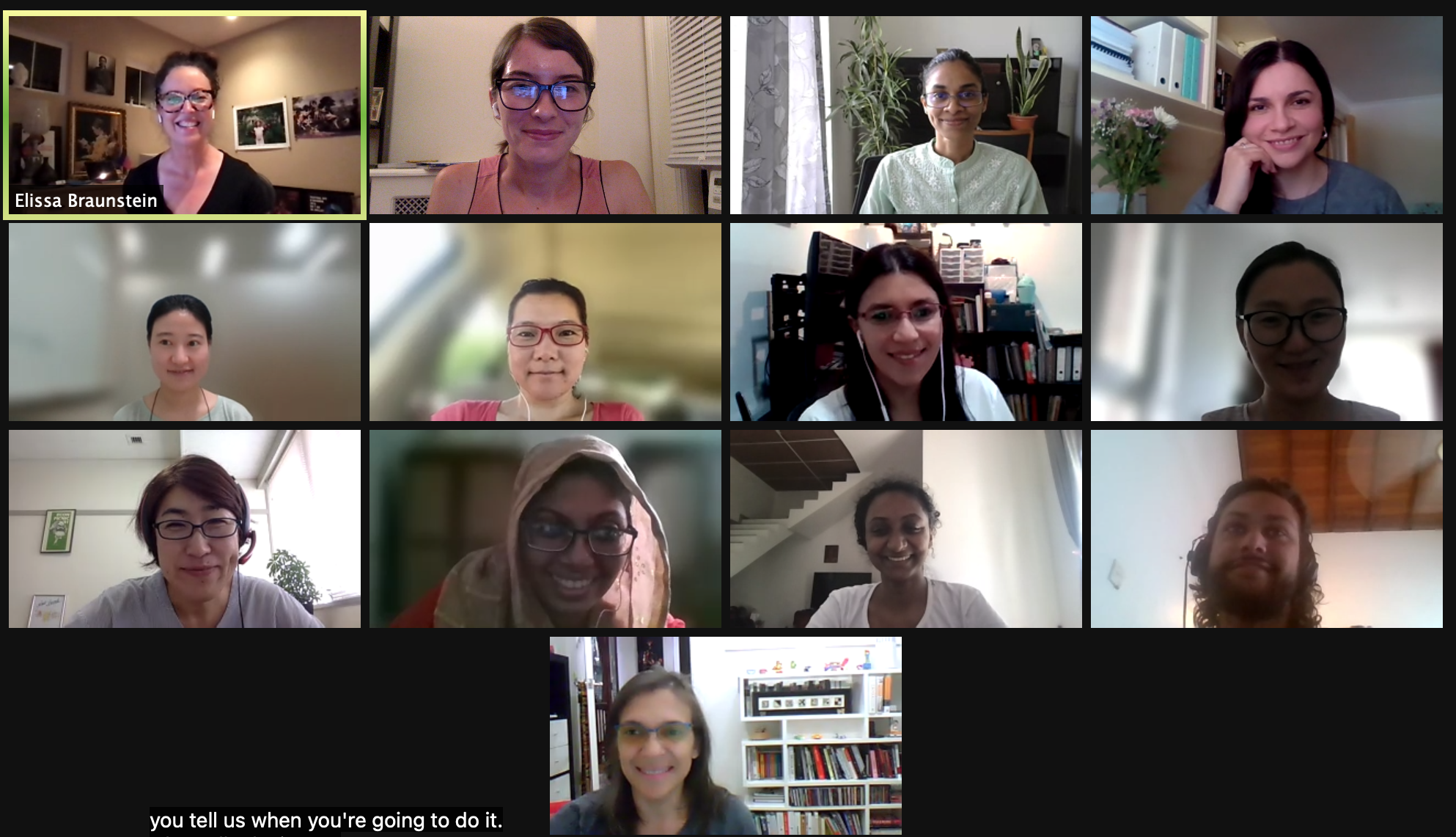
This blog was written by Lucie Prewitt, research and communications assistant for the Care Work and the Economy Project.
- Published in Gender-Aware Macromodels, Gender-Equal Economy, Intensive Course, Macroeconomics, Uncategorized
Investing in Quality Care has Positive Macroeconomic Effects
Recent research by Lenore Palladino and Chirag Lala of the Political Economy Research Institute (PERI), University of Massachusetts Amherst, examines the effects of critical public investment in childcare, home health care, and paid family and medical leave (PFML) for the U.S. workforce, as proposed by the American Jobs Plan and the American Family Plan by the Biden-Harris Administration.
The authors find that investing in childcare and home health care workforce has positive macroeconomic effects, and the care workforce spends its own money on goods and services through the rest of the economy. They also find that PFML positively boosts the economy, as workers spend the wage replacement income they earn.
The authors model the effects of a $42.5 billion annual investment in childcare and a $40 billion investment in home health care with a minimum wage of $15 an hour and find that the proposed investment can create 564,000 additional jobs throughout the economy, and results in an increase in labor income of $82 billion annually. They find that universal paid family and medical leave, as proposed by the American Families Plan, would increase household income nationally by $28.5 billion, of which $19 billion would be wage replacement directly from the paid leave program, and $9.4 billion would be income earned by workers throughout the economy as people receiving wage replacement spend money on goods and services. This means that for every dollar spent on wage replacement as part of the paid leave program, other workers would earn an additional $.50.
RESEARCH BRIEF: The Economic Effects of Investing in Quality Care Jobs and Paid Family and Medical Leave
This blog was authored by Shirin Arslan, program manager for the Care Work and the Economy Project.
- Published in Care Infrastructure, Child Care, Elder Care, elderly care, Gender-Equal Economy, Healthcare, Macroeconomics, Policy
Climate Change and COVID-19: Why Gender Matters
This article was originally published in the Georgetown Journal of International Affairs on July 9, 2021.
The COVID-19 pandemic highlights the important intersections of climate change, food security, migration, and socio-economic inequalities. An understanding of the gendered dimensions of these interconnected global concerns is crucial for developing a post-COVID recovery plan that ensures a more equal world and bolsters its resilience.
In many ways, the year 2020 spotlighted the compounding issues societies must reckon with, including climate change, COVID-19, and sustained inequality. Today, we are witnessing the drastic consequences of climate destabilization resulting largely from human actions: frequent heat waves, intense flooding and droughts, water crises, increased biodiversity loss, reduced agricultural productivity, and faster disease transmissions. Many of these underlying causes of climate change also increase the risk of future pandemics. For example, deforestation leading to loss of animal habitat forces animals to migrate and brings them into closer contact with other animals or people, increasing the likelihood of zoonotic transmission.
The effects of climate change are being felt throughout the world; its worst impacts are particularly damaging in poorer regions, such as those in sub-Saharan Africa, Latin America, the Caribbean, and Asia. Severe and prolonged droughts have already affected the Sahel and most of East Africa. Meanwhile, severe storms and flooding are causing extensive damage across the world, and climate change-related food insecurity has resulted in thousands of deaths. Climate change has also intensified water scarcity, reaching critical levels in seventeen countries. Major rivers no longer reach the ocean, while reservoirs and lakes dry up and underground water aquifers are depleted. As climate change continues, drier areas will only be more prone to drought and humid areas more prone to flooding. As food, water, and other resources become increasingly strained, fierce competition over scarce natural resources is likely to escalate. In fact, natural disasters and climate-related conflicts have already dislocated millions of people. In 2017 alone, the UNHCR estimates about 30.6 million new displacements associated with conflicts across 143 countries and territories.
Making Gender Visible in Climate Change Issues
It is fundamental to note that these aforementioned issues are gendered. Gender disparities in access to resources such as land, credit, and extension training have put many women at greater risk with regards to maintaining their livelihoods and accessing food and water. Climate change not only reflects pre-existing gender inequalities, but it also reinforces them. The pivotal role of women in food security is well-documented. Recent estimates for Africa indicate that women provide 40 percent of labor in crop agriculture while at the same time providing labor in small livestock, poultry, and other food production-related activities. Many are income earners, serving as breadwinners in female-headed households while performing most of the household and family care work. However, gender inequalities in the ownership and control of household assets, gender discrimination in labor markets, and rising work burdens due to male out-migration undermine women’s income generating capabilities. Much of women’s work in food production and food access remain statistically invisible because conventional economic indicators fail to capture the significance of their contributions—contributions that are also overlooked in policymaking.
The gendered consequences of climate change include effects on migration flows. Migration has diversifies livelihoods and serves as an important coping mechanism through the promise of remittances or a better life. Internal and international migrations involve individuals and families seeking protection as refugees from the violence in their communities and states and those whose livelihoods are threatened by natural or man-made factors such as natural disasters, economic crises, or political instability. More recently, the increased frequency of extreme weather events and high temperatures have led to climate-induced migration flows exemplified by the influx of climate refugees seeking entrance into the United States in response to hurricanes, and rural-urban migration in Vietnam in response to typhoons.
The ability of households and their members to relocate varies depending on their resources and their vulnerability to the risk of falling further into poverty. Both the gendered dimension of migration and the climate shock impact on migration decisions are nuanced. Migration can challenge certain social expectations and cultural norms. Household care responsibilities and gender roles may restrain women from migrating. In the case of increased conflicts over natural resources, for instance, women are less able to flee than men as they are often responsible for taking care of the children. In Indonesia, climate shocks have promoted more migration among men. Similarly, male migration in Ethiopia and Nigeria has increased with drought and weather variability, while women are forced to stay put due to financial constraints. On the other hand, increasing demands for care workers in countries with high female labor force participation and aging populations provides employment opportunities for women, fueling international migration flows. In 2019 alone 48 percent of the 272 million (3.5 percent of the world’s population) international immigrants were female.
Gender and the COVID-19 Pandemic
The trends in climate-induced problems have foreshadowed the severity of the crises induced by the COVID-19 pandemic. The pandemic has affected all aspects of everyday life and work and has placed a heavy toll on families, communities, and economies. It threatens food security for tens of millions of people. The COVID-19 crisis, like the climate crisis, is causing disparate impacts across nations and social groups. It poses a much greater risk to elderly persons and those with underlying risk factors. Countries with fewer economic resources and weak social and health infrastructure are at a higher risk, not only in the short term but also in the longer term. Politically underrepresented groups suffer the most from lockdowns, rising unemployment, and unexpected medical costs, exacerbating existing economic inequalities.
More importantly, the COVID-19 crisis also unravels and further amplifies gender inequalities. As millions of people lose their jobs or become forced to work from home, many, especially mothers, are compelled to simultaneously juggle work and childcare responsibilities. Unpaid care work has increased not only with children out of school but also with the heightened care needs of the elderly and the sick, especially when health services are either inaccessible or overwhelmed. Ultimately, many women are earning less, saving less, working precarious or insecure jobs, or living close to poverty.
Gender-based violence is rapidly increasing as well. Many women are being forced to “lock down” at home with their abusers at a time when support services for survivors are being disrupted or made inaccessible. In Peru, the imposition of lockdowns has led to a 48 percent increase in phone calls to the helpline for domestic violence.
The COVID-19 pandemic also exposes the precarious employment conditions of many “essential workers” whose jobs increase their risks of infection and are often employed on temporary contracts. Migrants are among the key workers who deliver essential services; they play a critical role in essential sectors in many high-income countries working as crop pickers, food processors, care assistants, and cleaners in hospitals. These migrant workers help facilitate systemic resilience to threats, but their own vulnerabilities go unaddressed.
Conclusions
We cannot afford to ignore the particular vulnerability of women when analyzing the effects of climate change on food security and migration, and we cannot ignore their susceptibility to food insecurity and violence. As governments and policymakers grapple with the challenge of bolstering resilience, they will need to think beyond the effects of these shocks on markets and to pay more attention to the heightened social and economic inequalities. Such an objective requires a comprehensive, gendered approach that considers women’s roles in the provision of essential goods and services and the differentiated impacts of climate change.
Fiscal stimulus packages and emergency measures have been put in place by many countries to mitigate the impacts of COVID-19, but it is crucial that these responses as well as post-COVID recovery plans put women and girls’ interests and needs, rights, and protection at their center. Such responses and plans should include expanded public investment in the care delivery system, from childcare to healthcare to eldercare, which the COVID-19 crisis has disrupted. There is also a need for gender-sensitive analyses of the effects of economic, social, and migration policies along with the development of legal frameworks that effectively address domestic violence. Meaningful participation of women in policy discourse and dialogue addressing climate change is vital as they are disproportionately vulnerable.
Governments should also undertake and support the collection of sex-disaggregated data on various economic, social, and climate-change related indicators as the lack of data is sometimes used as an excuse not to implement gender-responsive policies. As UN Women has stated, “it is not just about rectifying long-standing inequalities but also about building a more just and resilient world.”
This article was written by the CWE-GAM Project’s Principal Investigator Maria S. Floro and was originally published in the Georgetown Journal for International Affairs on July 9, 2021.
- Published in COVID 19, Economic Recovery, Feminist Economics, Gender Inequalities, Gender-Equal Economy, Maria Floro, Policy
CWE-GAM Scholars Leading Two Panels During 2021 IAFFE Annual Conference
This week, the International Association for Feminist Economics (IAFFE) will hold its Annual Conference: “Sustaining Life: Challenges of Multidimensional Crises” starting on Tuesday, June 22nd, and concluding Friday, June 25th. This conference will provide a forum for scholars to discuss feminist approaches to constructing “inclusive and resilient economic and political systems and [sustainting] our environment” in the context and aftermath of the COVID-19 pandemic.
The Care Work and the Economy Project will be leading two panel discussions on Wednesday, June 23rd and Thursday, June 24th: “Those Who Care: Improving the Lives of Caregivers and Workers” chaired by Elizabeth King and Ito Peng, and “Seeking Gender Aware Applied modelings: Case of South Korea” chaired by Young Ock Kim. In the discussions, CWE-GAM researchers will present gender-aware macroeconomic models, data collected from unique surveys of care providers and families, and microeconomic simulations used to better understand care work and the economy.
“Those Who Care: Improving the Lives of Caregivers and Workers” is scheduled for Wednesday, June 23rd from 3:30 to 5:00 pm (EDT time) and will contribute to ongoing efforts to “illustrate the intersectionality of care provisioning, economic growth, and distribution.” With an increasing need for care due to the rapid decline in fertility rates and aging population, South Korea offers a unique context to introduce models and analyze surveys given to households, child and eldercare workers.
There will be four papers presented in this panel:
“The Effects of Public Social Infrastructure and Gender Equality on Output and Employment: The Case of South Korea” by Cem Oyvat and Ozlem Onaran “introduces a post-Kaleckian feminist model to analyze the effects of public social expenditure and gender gaps on output and employment building on Onaran, Oyvat, and Fotopoulou (2019), and extending it with an endogenous labor supply and wage bargaining model.”
“The Quality of Life of Family Caregivers: Psychic, Physical, and Economic Costs of Eldercare in South Korea” by Jiweon Jun, Elizabeth King, and Catherine Hensly “examines the psychic, physical, and opportunity costs of caregiving within the family using data from a special-purpose national survey of 501 households conducted in Seoul in 2018.”
“Quality of Care, Commitment Level, and Working Conditions: Understanding the Care Workers’ Perspective” by Shirin Arslan, Maria Floro, Arnob Alam, Eunhye Kang, and Seung-Eun Cha uses “the 2018 Care Work Economy (CWE-GAM) survey data collected from 600 child and eldercare workers in South Korea [to] analyze patterns of commitment levels among [paid carers] in various settings such as private and public institutions as well as in homes of recipients by conducting tobit regressions and entropy econometrics for robustness checks.”
“Impacts of COVID-19 on Work-Family Balance in South Korea: Empirical Findings and Policy Implications” by Ito Peng and Jiweon Jun examines COVID-19’s unequal impact between men and women in South Korea using data from a survey distributed to “1,252 households with at least one child aged between 0 and 12 in June 2020 to find out how the first 2-month social distancing measure had affected their work, childcare arrangements, and their wellbeing.”
“Seeking Gender Aware Applied modelings: Case of South Korea” is scheduled for Thursday, June 24th from 3:30 to 5:00 pm (EDT time), which will share the results of gender-aware applied modelings and micro simulations for South Korea. The panel will discuss which fiscal policies are likely to be the most effective at reducing gender gaps in paid employment and which forms of public investment best contribute to reducing and redistributing unpaid work between genders and socio-economic groups.
There will be three papers presented in this panel:
“Child and Elderly Care in South Korea: Policy Analysis with a Gendered, Care-Focused Computable General Equilibrium Model” by Martin Cicowiez and Hans Lofgren presents the first care-focused and gendered model in the computable general equilibrium literature for Korea that “is built around a social accounting matrix (SAM) that covers non-GDP household services, singles out sectors for child and elderly care, and disaggregates households on the basis on care needs.”
“Care Support Ratios in Korea and the US” by Gretchen S. Donehower and Bongoh Kye takes a holistic view of care by including both paid and unpaid care for all age ranges and “create[s] [care support ratios] to understand the current care market and whether it is sustainable in the future…in two aging populations- Korea and the United States.”
“Towards a Caring and Gender-Equal Economy in South Korea: How much does the regulation of labor market working hours matter?” by Ipek Ilkkaracan and Emel Memis “use[s] a unique time-use survey on care arrangements by couples with small children in order to explore the potential of [the] reduction of full-time market work hours towards [the] narrowing of the gender gaps in paid and unpaid work.”
To learn more about the panels presented by CWE-GAM researchers and the IAFFE conference, please visit the IAFFE 2021 Annual Conference homepage and program.
This blog was contributed by Lucie Prewitt, a research assistant for the CWE-GAM project.
Making Care Count
The COVID-19 pandemic has informed our understanding of the care economy, exposing disproportionate inequities that must be addressed to alleviate the international erasure of care workers. These issues are addressed in the latest Susan and Michael J. Angelides Lecture, in which Naomi Klein moderates a discussion between Congresswoman Pramila Jayapal and CWE-GAM researcher Dr. İpek İlkkaracan on COVID-19 and the care economy.
We live in an economic system that has traditionally deprioritized and invisibilized care workers, many of which are women of color, migrant, and poor women. The economic crisis brought on by the pandemic has consequently given policymakers and academics “a once-in-a-generation opportunity to address [the valuation of care work] from an intersectional [approach],” states Congresswoman Jayapal.
The Care Crisis Exposed by the Pandemic Recession:
When mass unemployment hit during the pandemic, the cracks in the economic infrastructure of America began to show. As millions of people lost their jobs, the highest increase in the number of uninsured Americans was subsequently recorded. This high number of uninsured people is a direct consequence of healthcare being employer-sponsored. Congresswoman Jayapal notes that “Medicare For All would have strengthened the response to the pandemic…30 percent of COVID-19 deaths were related to a lack of insurance.”
While gains were made in the past decade in regards to gender equality in the workplace, Congresswoman Jayapal notes that “as soon as the pandemic hit, it was the women who went back to taking care of [their] families.” Dr. İpek İlkkaracan explains that this is because “the nature of women’s employment is often determined by their care responsibilities…unpaid care work is often articulated as one of the most significant barriers to labor force participation.” This notion was reflected in jobs reports—in December of 2020, women accounted for 100 percent of job loss, and within that, 154,000 Black women exited the workforce.
In its current state, the care economy produces a pattern of inequality that disproportionately affects women of color and migrant women. The average caregiver salary is $12.74, and the care work sector is marked by poor working conditions with no adequate social protections and low wages. This is why, as Congresswoman Jayapal notes, the fight for one fair wage is pertinent. “An increase in the minimum wage would give 32 million workers a raise, 60 percent of which are women while 1 in 4 of the women who would benefit from this increase are Black or Latina.”
A Framework for a More Caring Economy:
Dr. İpek İlkkaracan has developed a framework that acknowledges the care economy. This framework, coined as the Purple Economy (a nod to the color representative of many women’s movements), envisions a gender-egalitarian and caring economic system. Dr. İlkkaracan recommends “labor market regulations and investment in care services such as long-term care, early childhood education, education, and healthcare” as policy interventions to start the process of adequately valuing care.
Not only is investment in care important from a humanitarian and ethical perspective, but it is also conducive to economic stability. Dr. İlkkaracan’s research has revealed that investment in care services produces a high employment multiplier: for every dollar invested in care, three times as many jobs are created in the wider economy. This is because the care sector is intertwined with other sectors such as food, transport, and financial services. In the Asia-Pacific region, Dr. İlkkaracan’s research has shown that “up to four trillion dollars could be added to GDP if unpaid care work (75% of which done by women) was valued in market terms.” While this may seem astronomical, the amount of unpaid work completed globally in one day equates to 16.4 billion hours—which translates to two billion full-time jobs. Dr. İlkkaracan’s recent research also reveals that a “3.5-4% commitment of GDP to investment in care services would create 120 million additional jobs and have a large impact on poverty alleviation.”
To watch the full conversation and learn more about the Purple Economy, see below.
Dr. İpek İlkkaracan is a CWE-GAM researcher a part of the Rethinking Macroeconomics and Gender Aware Applied Economics Working Groups.
This blog was authored by Lucie Prewitt, a research assistant for the CWE-GAM project.
- Published in Child Care, COVID 19, Economic Recovery, Gender-Equal Economy, Policy, Rethinking Macroeconomics, U.S.
Engendering the Macroeconomy: Current Efforts and Future Directions
On International Women’s Day earlier this month, the Whitaker Institute hosted a webinar titled “Engendering the Macroeconomy: Current Efforts and Future Directions” featuring Dr. Maria S. Floro, Principal Investigator of the Care Work and the Economy Project (CWE) and CWE contributing researcher Dr. Srinivasan Raghavendra. Dr. Raghavendra also serves as Co-PI of DFID funded research on “Economic and Social Costs of Violence Against Women and Girls.” This session was hosted by Dr Nata Duvvury, co-leader of the Gender and Public Policy cluster at the Whitaker Institute.
The webinar focused on exploring what engendering the macroeconomy entails, current efforts, and future directions. The discussion provides insight into ways to bring gender dimensions into macroeconomics by incorporating unpaid and paid care of children, the sick, disabled and the elderly into existing macroeconomic models, the interdependency between the market economy and the care economy, and how gender blindness of macroeconomic models are reflected through every crisis.
This blog was authored by Jenn Brown, CWE-GAM Communications Assistant.
- Published in Economic Recovery, Expert Dialogues & Forums, Gender-Equal Economy, Macroeconomics
Spirals of Inequality: A Women’s Budget Group Special Report
The Women’s Budget Group Commission on a Gender-Equal Economy, launched in February 2019, is an expert-led project aimed at developing economic policies that promote gender equality across the United Kingdom. The Commission utilizes a number of avenues and tools to achieve this objective, one of which is the recent release of the report “Spirals of Inequality: How Unpaid Care is at the Heart of Gender Inequalities.”
This first report released by the Commission seeks to trace the problem of how gender inequalities in the UK are produced and maintained by observing the problem through the following perspectives:
Unpaid Work: Women Continue to do the Lion’s Share
The unequal division of labor within unpaid care work is at the heart of gender inequality in the UK, with women taking on 60% of the unpaid work on average. This includes care work, cooking, and cleaning among other tasks.
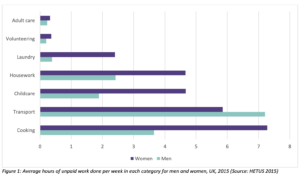 This proportion of unpaid work has increased between 2000 and 2015. Seeing that unpaid work is indispensable to both the function of society and the economy, feminist economists have argued for unpaid work to have recognition in systems of national accounting. These campaigns have led to the UK Office for National Statistics to develop estimates; the most recent from 2014 valuing unpaid care work £1.01 trillion.
This proportion of unpaid work has increased between 2000 and 2015. Seeing that unpaid work is indispensable to both the function of society and the economy, feminist economists have argued for unpaid work to have recognition in systems of national accounting. These campaigns have led to the UK Office for National Statistics to develop estimates; the most recent from 2014 valuing unpaid care work £1.01 trillion.
Limiting Opportunities for Paid Work: Women More Likely to Work Part-Time and Earn Less
This phenomenon puts a disproportionate strain on women and contributes to gender inequality. Mothers with young children are 3-4 times more likely to work part-time, and women, in general, are far more likely to be in precarious forms of employment such as temporary work. This is especially true for women of color. The part-time work conundrum is driving the gender gap, and on average women earn 43% less than men. Furthermore, a pay gap of 8.9% persists, further exacerbating this issue. Again, this being more predominate with women of color.
Despite women becoming increasingly educated, they persist in being overrepresented in low-wage sectors of the economy such as health and social work. Feminist economists have argued that a reason behind this is such sectors are viewed as an extension of a women’s “natural” work.
These issues create a perpetual cycle that allows for the inequality between men and women to continue.
Life Course Implications: Benefits Make Up a Larger Portion of Income and Austerity Hits Harder
Among single households living in poverty, those led by women make up for 86%. Furthermore, pensioners living alone are far more likely to be at the poverty level if that individual is a woman. Since tax reforms began in 2010 throughout the UK, women have also been hit hardest. These benefits make up a large portion of women’s incomes and cuts to these benefits and tax giveaways benefit those fitting into a higher wealth bracket.
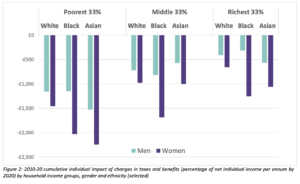
Public Services: Women Hit Hardest by Cutbacks
Cuts to public spending throughout the UK have also hit women disproportionately hard, as women are most likely to utilize public services. The poorest families and especially those in poverty-level households led by women have taken a particularly bad hit; many single mothers have had to cut living standards by up to 10% as a result of a cut to public services between 2010 and 2017.
Furthermore, these cuts have put a greater burden on family members to provide care for the elderly members of their family, much of this falling onto female members. This often comes at the expense of their own employment.
Violence Against Women: “Cause and Consequence” of Women’s Economic Equality
All of the factors that lead to the economic disparity between men and women also make it increasingly difficult for women to leave abusive partners. Furthermore, poorer households have higher rates of domestic abuse, and this perpetuating poverty limits women’s options while increasing their vulnerability.
Moving Forward: Next Steps for the Commission
The WBG Commission on a Gender-Equal Economy is striving to develop an alternative economic approach aimed at addressing these issues. Through this initiative, they aim to build an economy that is desirable, economically feasible, and necessary for fairness, sustainability, and resilience. To learn more about the Commission and its work, sign up to attend the upcoming webinar “Creating a Caring Economy: A Call to Action” on September 30, 2020.
This blog was authored by Jenn Brown, CWE-GAM Communications Assistant
- Published in Child Care, Feminist Economics, Gender Inequalities, Gender-Equal Economy
Webinar (09/30/2020): Creating a Caring Economy
On Wednesday, September 30th at 10:00 -11:30 am BST, the Women’s Budget Group (WBG) will be a hosting a webinar titled “Creating a Care Economy” which will discuss the work being done within the Commission on a Gender-Equal Economy and the launch of its digital final report. This report comes at a unique time in our history, amidst a devastating global pandemic and on the brink of a harsh economic recession. The commission has taken this unprecedented time to pose the question: “do we really want to go back to business as usual?”
The Women’s Budget Group, (WBG) based out the United Kingdom, is an independent network of policy experts, academic researchers, and campaigners, harboring a vision of a “caring economy that promotes gender equality.” This non-profit organization works hard toward producing vigorous analysis intended to influence policymakers while also building the knowledge and confidence of individuals to talk about feminist economics. WBG achieves this through offering training and creating resources that are accessible and informative.
In February of 2019, WBG launched the Commission on a Gender-Equal Economy. This project works proactively to develop policies that promote gender equality across the UK, and is the first of its kind. This commission is chaired by Diane Elson.
The commission has thus far produced a number of helpful resources. To begin they have produced a short video entitled Spirals of Inequality which delves into how unpaid care is at the heart of gender inequality. This video is also accompanied by a short brief and a longer, more in-depth accompanying paper. They also have an ongoing blog, and have commissioned a number of papers focusing on four areas: Public Services, Social Security and Taxation, and an Enabling Environment. Additionally, they have gathered a number of calls for evidence, which collects evidence from many experts in varying sectors.
The final report that will be explored within this upcoming webinar will lay out a roadmap in which to build a more caring economy, outlining out the how, the why, and acting as a call to action across all the four nations encompassed within the United Kingdom.
Learn more and register for the webinar here.
- Published in Events, Gender-Equal Economy
Playing the Long Game: How a Gender Lens Can Mitigate Harm Caused by Pandemics
When crisis hits, longer-term thinking can easily, and understandably, be cast as a distraction or a luxury—even when it relates to tackling critical issues like gender inequality, climate change, or extreme poverty.
Speaking personally, I’ve felt a bit silly trying to push forward projects that focus on gender lens investing or women’s economic empowerment in the last few weeks, given that my colleagues’ and collaborators’ attention, and frankly much of my own, lies elsewhere, and with something that seems much more pressing.
But for those of us who are in the position of privilege to continue thinking long term, it’s our responsibility to do so. Working towards structural changes that will take longer to come to fruition, especially those that relate to reducing global inequality, is the only way to radically decrease the extent of harm caused by moments of crisis, especially for vulnerable populations.
Dismantling unequal power structures, and in turn ensuring that every individual—regardless of gender, age, income level, national origin, and so on—has a safety net protecting them from vulnerability to health scares, income loss, and threats of increased violence, will allow us to focus on crisis without fearing fallout across every dimension of life.
In times of pandemic, the economically vulnerable cannot afford to stay home. Women in quarantine are facing increased risks of intimate partner violence. Girls staying home from school in some parts of the world may not have the opportunity to return. And none of this would be the case if we more effectively tackled the forms of inequality that underlie these realities. Then a virus could be a virus — assuredly deadly and destructive from a health perspective – but without inciting increased abuse, poverty, and lost prospects.
My colleague David Evans, drawing upon work by Claire Wenham, Julia Smith, and Rosemary Morgan in The Lancet, recently highlighted a range of problems stemming from the COVID-19 pandemic that disproportionately impact women and girls. In hopes of continuing to move the conversation forward, I propose some solutions to those problems here, and welcome others to add to this initial list. To be clear, these actions should not distract from immediate measures to address the pandemic. But we also can’t afford to risk forgetting about them when the focus on COVID-19 has faded; otherwise history is doomed to repeat itself.
1. Promote a Gender-Equal Health Workforce
Because the health workforce is disproportionately women (67%), women are at a higher risk of exposure to the virus within medical facilities.
More doctors worldwide are still men. But the vast majority of the global health workforce consists of nurses, community health workers, and others who are less highly compensated. All health workforce jobs need to become increasingly well-compensated, high-quality jobs. Not only will this incentivize men to seek these positions, destigmatizing their current positioning as “feminine” and dismantling occupational sex segregation within the healthcare sector, but it will also ensure that those on the frontlines of protecting populations from pandemics don’t also have to fear economic fallout on a day-to-day basis.
The number of women doctors is rising. Research from other sectors tells us what works to combat occupational sex segregation, including men acting as mentors supporting women to “cross over” into higher-paying occupations. These efforts will have to be paired with those that increase the perceived (and actual) value of work in sectors, including nursing and other frontline health work, where women dominate. More research is needed on this front, both on what works to incentivize men to take up traditionally “feminine” roles and how to avoid unintended displacement of women from those occupations.
2. Protect (and Expand) Existing Health Resources
With all hands on deck to fight COVID-19, particular groups of women and girls face other health risks.
Health facilities should not have to choose between providing lifesaving care in the face of pandemics and continuing to provide support for those in need in other areas, including pregnant women, adolescent girls (who have the highest prevalence of HIV infection, and in need of life-saving medication to keep their immune systems strong), and all women and girls in need of contraceptive access.
Increased investments in health are needed to ensure critical day-to-day care is not compromised during times of crisis. Establishing a Global Health Security Challenge Fund would help ensure countries are prepared to balance day-to-day needs with additional burdens in the face of pandemic, and evidence-based prioritization strategies are needed for when resources cannot be expanded.
3. Reduce and Redistribute Unpaid Care Work Burdens
As schools close and people fall ill, women and girls will assume increased unpaid care work burdens.
Under business-as-usual scenarios, women and girls do more than their fair share of unpaid care work, which limits their educational attainment, workforce participation and advancement, and leisure time. To lessen these burdens in times of crisis and more generally, we need increased investments in child and elder care, and in the poorest countries, gender-responsive energy, water, and sanitation infrastructure that would reduce the time women and girls must spend collecting water and fuel, as well as cooking and cleaning. We also need shifts in household norms that mean men assume more unpaid care responsibilities. Initiatives focused on promoting women’s economic empowerment, such as 2X Challenge and the Women’s Global Development and Prosperity (W-GDP) initiative, as well broader investments in gender equality and economic growth, must prioritize reducing and redistributing women and girls’ unpaid care work.
4. Address Gender-Based Violence
With quarantine measures imposed and stress heightened, women are at increased risk of violence committed by their partners and family members, and essential support services are absent.
Early reports suggest that gender-based violence rates are increasing in light of COVID-19 quarantining, consistent with evidence documenting increased violence in other crisis settings. Gender-based violence needs to be elevated as its own public health crisis, and resourced accordingly.
We’re far from meeting this objective, considering that all OECD donors combined allocated less than $200 million to addressing violence against women according to 2016-17 data, and over half of this financing came from just three countries (Australia, Canada, and Norway). Increased resources should target evidence-based approaches, such as Promundo’s MenCare program.
In pandemic contexts, preparations for social distancing should include considerations of how individuals will be able to access social services when faced with violence in their households. The World Bank has taken a step in the right direction in positioning interpersonal and gender-based violence as priorities to address in its new Fragility, Conflict, and Violence Strategy, though time will tell how the bank and other donor institutions finance this priority.
5. Guarantee Girls’ Education
With schools closing as part of social distancing measures, girls who already face pressure to drop out of school may not return.
Even absent crisis, tens of millions of girls globally face pressures to drop out of school to care for siblings and do other unpaid domestic work, contribute to supporting their households financially, and/or marry and have children when they are still children themselves. These pressures may be heightened due to interruptions in their education, as observed when Ebola hit West Africa. School closures, especially those impacting adolescent girls, should be weighed against longer-term risks related to girls’ school drop-out and limited school-to-work transition prospects as a result. Where possible, efforts should be made to incentivize parents to allow their children to return to school and to ensure consistent access to sexual and reproductive health services in the interim, as unintended pregnancy is cited as a reason for girls’ failure to return to school.
6. Promote Women’s Economic Opportunities
Across the globe, women are more likely to work jobs that are low-paid, informal, and lacking in benefits.
In large part due to the disproportionate unpaid care work women take on, they are less likely to be employed full-time, in the formal workforce, or in jobs that provide paid sick leave, unemployment insurance, and other protections.
We must continue to invest in evidence-based programs and policies that improve women’s economic opportunities and support organizations such as the Self-Employed Women’s Association and Women in Informal Employment: Globalizing and Organizing—organizations that are well-positioned to provide and advocate for dignified work.
Cash transfers should be considered as a means of ensuring a social safety net for those most in need. Critical to transfers’ success will be (1) ensuring that delivery mechanisms (through digital technology or otherwise) are properly designed and implemented and (2) that those in need, including low-income populations and workers vulnerable to economic backslides because of the virus, are prioritized.
7. Ensure Women’s Representation in Decision-Making and Critical Research
Women are not equally represented in decision-making roles responding to the COVID-19 pandemic.
The White House Coronavirus Task Force is over 90 percent men, and the team Prime Minister Johnson just assembled to lead the United Kingdom’s COVID-19 response is all men. As in the contexts of peace and security, international trade, and climate change, an exclusionary approach to decision-making will yield inferior decisions: those that don’t account for the needs and constraints of populations absent from the table.
Going forward, decision-making teams should be equally representative of men and women, and also prioritize other forms of inclusion, such as those based on race and ethnicity, as called for by Women in Global Health’s Operation 50/50 campaign.
Women must also be equally represented in clinical trials as biomedical treatments and other interventions are developed. As my colleague Carleigh Krubiner has noted speaking to the context of Ebola, women who are pregnant or breastfeeding are typically excluded from experimental studies, and in some high-fertility contexts, this means up to 80 percent of reproductive age women are virtually invisible in trial samples. Lack of representation means a lack of essential data on the types of prevention methods, treatments, and other interventions that work for women, risking higher fatality rates and other complications.
Times of crisis magnify the cracks in our systems and highlight disproportionate risks to the most vulnerable among us. COVID-19’s impacts, those already felt as well as those still anticipated, should serve as a wake-up call. They should spur action to address underlying inequalities, including those that disadvantage women and girls worldwide and make the consequences of a pandemic even worse than they would otherwise be. Increased prioritization of women and girls’ health, education, economic opportunity, safety, and decision-making power can help create a world where no one falls through the cracks. Decision-makers should realize this is inextricably linked to today’s pandemic response.
Contributed by Megan O’Donnell Assistant Director, Gender Program and Senior Policy Analyst at Center for Global Development
Original blog published on Center for Global Development website March 18, 2020, see here for the original post
Reposted with permission from Megan O’Donnell Assistant Director, Gender Program and Senior Policy Analyst at Center for Global Development
- Published in COVID 19, Gender-Equal Economy, Healthcare

